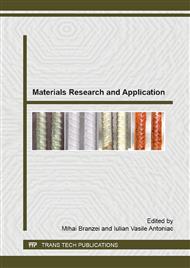p.224
p.229
p.233
p.239
p.247
p.253
p.258
p.266
p.272
Biomaterials View on the Complications Associated with Hip Resurfacing Arthroplasty
Abstract:
Hip resurfacing arthroplasty is an very interesting and controversial orthopedic concept in the last years [1]. In order to avoid the previous problems associated with the classical hip prosthesis type metal-polyethylene [2], different manufacturer propose the metal-metal prosthesis based on the reproducible quality of manufacturing of metallic components using Co-Cr alloys and better component fixation. Problems that have been encountered to be the reason for failing of the prosthesis can be different (dislocation, femoral neck fractures, vascular damage, avascular necrosis, raised metal ion levels), and could be related to three main aspects: factors related to the patients, surgical intervention and prosthesis [3, 4]. But a very important aspect is the biomaterials used, that will be discussed in the present paper in correlation with biomechanics and clinical aspects. Our study maked on a lot of retrieved BHR prosthesis used in one Romanian orthopaedic clinic present a higher rate of failure than the other similar studies made by other authors [5]. Starting from this point, we analyze carefully many components of the failed BHR prosthesis using stereomicroscopy, scanning electron microscopy (SEM) and EDS. Based on our experimental results especially at the interfaces metal-cement-bone, we identify different potential causes of failure but the main conclusion was that the cementation technique and poor quality of the patient bone are the reasons for most of hip resurfacing prosthesis failure. As future recommendations for the orthopaedic surgeons we could mention the carefully analysis of bone quality for each candidate using advanced techniques like DEXA and a correlation between the bone cement used for prosthesis fixation and the cementation technique.
Info:
Periodical:
Pages:
247-252
Citation:
Online since:
July 2015
Authors:
Keywords:
Price:
Сopyright:
© 2015 Trans Tech Publications Ltd. All Rights Reserved
Share:
Citation:


